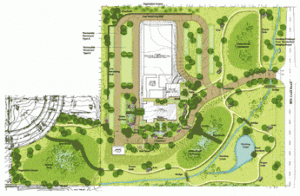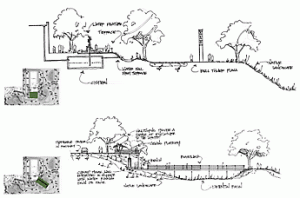
In the same sense as our iconography, our sprawling, ten acre grounds communicates our spirituality. The continued development of our landscaping by means of a master plan for water management and sustainable environment will include shrines and prayer paths with an emphasis on indigenous vegetation. The native wildlife of our region finds our property to be very accommodating.
The following scenario is used to describe the experience one would have at Annunciation Parish once this Landscape Master Plan is fully realized…
When we accepted Father Tom’s invitation to visit the church, we had no idea what to expect. Over the phone, he described his vision for Annunciation Parish as that of a “church in a forest preserve”, in other words, a church that is surrounded by nature, “which is exactly what the landscape master plan accomplished, and more” he adds.
Arriving at the church, we immediately notice a difference; the road upon which we are driving is no longer asphalt but an array of rich colors and textures. The road that leads us to the church is now made of permeable paving, a surface that allows direct infiltration of rainwater. As we make our way up to the church, another noticeable difference is the number of people walking the site, especially the children. We will soon learn that the church had facilitated the installation of a series of trails to connect the adjacent neighborhoods, making the church not only a destination, but a safe way for children to move from one place to another.
At the church’s main entrance, we are greeted by Father Tom just as it begins to rain. Instead of running for cover, he hands each of us an umbrella and smiles. “Welcome” he says with a smile, “don’t mind the rain, it is actually the perfect accompaniment to our journey.” The tour begins with an explanation of the landscape we just drove through, “as you may have noticed, our site is one contiguous native landscape that reaches out to the road. This is in stark contrast to all of the other properties seen elsewhere in this area. No longer an expanse of turf grass lawn, our landscape is an interconnected group of healthy ecosystems comprised of wetlands and prairie.” Continuing, he adds, “the landscape before you is meant to restore the flora indigenous to this bioregion, which will allow God’s creatures, never before seen at the church, to find a home. The entire landscape will support a restoration of the mind and spirit, rejuvenating the place and the people that enjoy it.”
As the rain begins to come down harder, Father Tom points to the porte cochere and tells us to watch the roof. “On our old rooftop, water would be pouring down a downspout right now, and spilling onto the road.” “Now,” he explains, “rain is captured by a green roof with only overflow rain coming down, which, by the way, is much cleaner and a blessing for the water garden that we are standing next to.” With all of our attention on the roof, we did not fully comprehend the water garden that is now the church’s main entry feature. “This island used to be junipers and bark mulch, now you enter the church over this small bridge and across a vibrant display of water lilies, arrowhead, pickerel weed, rushes, and more.” To our amazement, Father Tom points out the blue heron standing motionless at the waters edge, waiting patiently for a frog to join him for lunch.
After a few more minutes of a continuous hard rain, the green roof has saturated to the point where overflow water enters the scupper and flows in a comely fashion down the chain links, an artistic display that sets the rain softly into the water garden. Father Tom, now smiling bigger than life, motions us to follow him. “If the water builds up more than an inch or two in the water garden,” he explains, “it overflows through this runnel in the sidewalk, past this terrace, and into the cistern below, where it is recirculated through the water terrace. Run-off from the main roof of the church is also collected and stored in the cistern where it is recirculated through the water terrace and rain garden.” Pointing back behind us, he explains that “the rain garden is a type of cleansing biotope and helps to remove algae and dirt particles, which assures that the system is run with high-quality water.” As we move across the terrace, we are promised that the rain will stop soon since there is an outdoor wedding that afternoon. “The water terrace was located on this side of the church so that members can come straight out of the nave and take advantage of the views across the property. It also serves us well as a place for weddings, informal gatherings, socials, and fund raising events” he says with a wink.
Despite the continued rain, Father Tom’s spirits couldn’t be higher. “Come over here, you have to see this as well,” he says. Walking toward the road, he stops and points, “look! not a single drop of water leaves the pavement, every drop goes into the ground”. Sure enough, just as he said, every drop of water that falls on the permeable pavement disappears. “That”, he says “is the key to a successful restoration effort in our detention basins. Because most of our rain, roughly 90%, comes in small amounts throughout the year, the porous pavement is able to infiltrate it, along with the road oil and grease that accumulates, thus providing a healthy environment for native plants in the basins”. As he further explains, “a typical detention basin receives all of the site water from rooftops, pavement, and turf grass every time it rains, which compromises the ability of native plants to grow in such an environment. Our detention basins, however, are alive with plants and animals.”
As we move toward a small overlook, Father Tom points across Will-Cook Road and tell us that his dream is to, one day, work with the adjacent property of the forest preserve and have them restore the native landscapes on their property. “From here”, he says, “a system of trails could radiate out, with Annunciation Parish at the hub. The trails would connect a series of parks and open space for existing and future residents of Homer Glen, not unlike the Emerald Necklace in Boston or Cleveland, my home town”. He says this with such confidence that we have no problem believing him and his vision.
Looking down from the overlook, we ask about the boardwalk that disappears below us. “Ah, that boardwalk leads to a very sacred space. It is our grotto.” This, we have to see. As we make our way down the hill, through the native landscape, around the pond, and toward the grotto, Father Tom describes the small spaces we are passing along the prayer path. “Each space is tucked into the landscape in order to create an intimate sanctuary for quiet contemplation and reflection.” We are amazed at the uniqueness of each space; all have been designed with seating, some form of sculpture or Byzantine icon, and a small water feature. Because of the movement of the path, each space is set apart from the next, making each encounter a surprise. We are also taken by the sights and sounds of the prairie, all around us are birds, butterflies, and dragonflies. Their beauty is surpassed only by the color and texture of the plants that make up the native landscape. As we cross a small bridge over the existing creek channel, a green heron suddenly takes flight in front of us. Father Tom jumps and laughs, “I love it when any of God’s creatures visit the church.”

Water Terrace / Grotto & Overlook
Turning our attention toward the grotto, we can see that it is quite different. Instead of being enclosed by stone, as most grottos are, this one is overhung by a number of hawthorn trees, which creates a sense of enclosure that fits nicely with the vernacular of the Midwest prairie. Stepping onto the boardwalk that crosses the naturalized detention basin, we are overcome by a sense of reverence for the space. Moving closer, we can see a curving wall embedded in the hillside below the hawthorns; their low-spreading branches provide the perfect cave-like effect in a landscape that is otherwise smooth and undulating. Standing in the grotto, we are treated to the story of the glorious mosaic that depicts Christ in the Jordan River. There is a slight shimmer to the wall as water sheets down the face and drops into a small pool at its base. “The amazing thing” he says “is that the water on the wall is rain water collected from the church roof, every drop of water that falls from the sky is treated as a precious resource and used in every facet of the landscape, even here in the grotto”. The sound of the water trickling down the wall is very soothing and invites us to stay a little longer. While here, Father Tom tells us that the recently established parish is developing as a center in the Midwest for learning and spiritual enrichment. The parish is a place to learn and live the gospel of Jesus Christ as communicated through the specific spiritual heritage of Eastern Christianity and the cultural heritage of the Ruthenian ecclesiastical jurisdiction. He ends by saying that “the natural environment that we recreated here and the gift of water throughout the site are key components to that enrichment. As a matter of fact, Annunciation Parish was the recipient of the Community and Nature in Harmony award recently presented to us by Homer Glen”.
Motioning to us to follow, Father Tom says that there is one more part of the property that we must see. As we head back across the boardwalk, his exuberance seems to rise a bit. Turning right and walking along the base of the hill, he points ahead and says, “this is the piece that started the whole process. It’s not exactly on the church property, but it was the impetus to all of the change you have seen today”. Perplexed, we follow the prayer path to another boardwalk that leads out to a small deck in the middle of what looks like a wetland. The deck is moderate in size and displays a number of educational signs at the edge. These signs describe what a wetland is, the plants that naturally occur here, and its role as a home to many living things. “This”, he says, “started it all. What used to be a detention basin, mown by the neighbors, is now a nature park visited by countless children and adults. Even grade schools from Homer Glen bring classes out here”.
go to TECHNIQUES